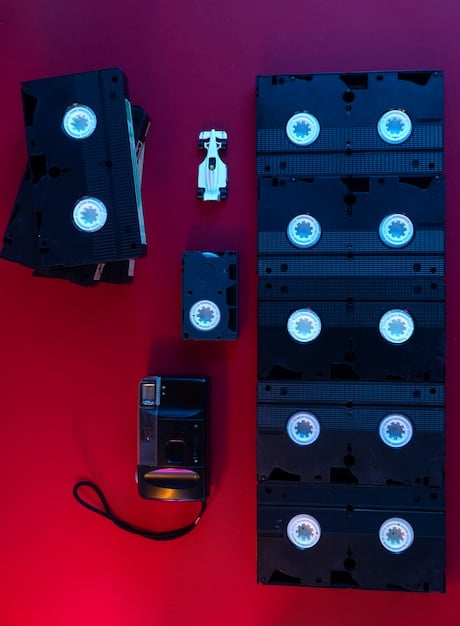8GB vs 16GB Graphics Cards in 2025: Real-World Performance

In 2025, the real-world performance difference between 8GB and 16GB graphics cards will largely depend on the resolution, game settings, and specific titles being played, with 16GB cards providing a noticeable advantage in demanding scenarios and future-proofing.
Is upgrading to a 16GB graphics card from an 8GB one really worth it in 2025? The answer isn’t as straightforward as the numbers suggest. Let’s dive into the real-world performance difference between 8GB and 16GB graphics cards in 2025, considering evolving game requirements and technological advancements.
8GB vs 16GB Graphics Cards: A 2025 Landscape
With gaming technology constantly evolving, understanding the practical impact of VRAM (Video RAM) is crucial. This section explores the factors that influence how 8GB and 16GB graphics cards perform in 2025’s gaming environment.
The amount of VRAM on a graphics card directly influences its ability to handle textures, frame buffers, and other graphical data. In 2025, the demands on VRAM will be higher than ever due to increased resolution gaming and more complex game designs.
Factors Influencing VRAM Usage
Several factors determine how much VRAM a game requires. Understanding these factors helps in predicting the performance differences between 8GB and 16GB cards.
- Resolution: Higher resolutions, like 4K, demand significantly more VRAM compared to 1080p.
- Texture Quality: High-resolution textures consume a large amount of VRAM.
- Game Complexity: Games with detailed environments and complex effects require more VRAM.
Ultimately, the choice between an 8GB and 16GB graphics card in 2025 hinges on how these factors align with your gaming preferences and targeted performance levels.

Performance at Different Resolutions
The resolution at which you game has a significant impact on VRAM usage and the resulting performance. Here’s how 8GB and 16GB cards are expected to perform at different resolutions in 2025.
Gaming at 1080p generally places less strain on VRAM compared to higher resolutions. However, even at 1080p, some modern games with high texture settings may benefit from the extra VRAM of a 16GB card.
1080p Gaming
At 1080p, an 8GB card is usually sufficient for most games. However, some exceptionally demanding titles might show performance improvements with a 16GB card, especially with ultra texture settings.
1440p Gaming
1440p gaming starts to push VRAM requirements higher. A 16GB card provides a more comfortable experience, especially in graphically intensive games. The 8GB cards may struggle in certain situations, causing stuttering or reduced frame rates.
4K Gaming
4K gaming is where the benefit of 16GB VRAM becomes most apparent. At this resolution, the increased texture detail and higher rendering demands mean that 8GB cards are likely to be a bottleneck in many modern games. A 16GB card will offer smoother gameplay and the ability to use higher settings without performance degradation.
In summary, the resolution at which you intend to game will be a crucial factor in determining whether an 8GB or 16GB graphics card is the right choice for you in 2025.
Game Settings and VRAM Requirements
Beyond resolution, the graphical settings chosen within a game significantly impact VRAM usage. Higher settings, such as ultra textures and advanced effects, can quickly exhaust the available VRAM on an 8GB card.
Texture quality is one of the biggest consumers of VRAM. Using high or ultra textures can significantly increase the amount of VRAM a game requires. Advanced lighting and shadow effects also contribute to VRAM usage.
Impact of High Texture Settings
When VRAM is insufficient, the graphics card must rely on system RAM, which is much slower. This can lead to noticeable performance degradation, including stuttering and reduced frame rates.
Balancing Settings for Optimal Performance
To mitigate VRAM limitations on an 8GB card, gamers may need to lower texture settings or reduce the quality of certain visual effects. This can help maintain playable frame rates, but it also means sacrificing some visual fidelity.
- Lowering Texture Quality
- Reducing Shadow Detail
- Disabling or Reducing Ambient Occlusion
The increased VRAM capacity of a 16GB card allows gamers to enjoy higher settings without compromising performance, resulting in a more immersive and visually appealing gaming experience. Therefore, understanding how game settings affect VRAM usage is essential for making an informed decision about your graphics card.
Specific Game Titles and Their Demands
Different games have varying VRAM requirements based on their graphics engines, texture quality, and overall complexity. In 2025, understanding the specific demands of popular and upcoming titles will be crucial to choosing the right graphics card.
Some open-world games, with their expansive environments and detailed textures, are particularly demanding on VRAM. Simulation games, with their complex calculations and high levels of detail, also tend to require significant VRAM.
Games That Benefit from 16GB VRAM
Titles with high-resolution textures and advanced effects will greatly benefit from the increased VRAM capacity of a 16GB card. Games that implement ray tracing, for example, often require more VRAM to handle the additional calculations.
Future-Proofing Considerations
Investing in a 16GB card can help to future-proof your system, ensuring that you’ll be able to play upcoming games at high settings without encountering VRAM limitations. As game development continues to push the boundaries of visual fidelity, VRAM requirements are only likely to increase.

The Role of Ray Tracing and Other Advanced Technologies
Ray tracing and other advanced graphical technologies are becoming increasingly prevalent in modern games. These technologies often require significant amounts of VRAM to function effectively. Understanding how these technologies impact VRAM usage is crucial for making an informed decision about your graphics card.
Ray tracing simulates the way light interacts with objects in a scene, creating more realistic lighting and reflections. This technique is computationally intensive and requires significant VRAM.
- Ray Tracing Impacts
- Mesh Shading
- AI Upscaling
In summary, as ray tracing and other advanced technologies become more common, the demand for VRAM will continue to increase, making 16GB cards an increasingly attractive option for gamers who want to experience the latest visual innovations. Gamers should consider the role of advanced technologies when evaluating their VRAM needs.
Price and Availability in 2025
The price and availability of graphics cards can significantly influence your purchasing decision. In 2025, the cost difference between 8GB and 16GB cards will likely narrow, making the latter a more accessible option. However, market conditions and manufacturing processes can still impact availability and pricing.
The cost of graphics cards is influenced by several factors, including manufacturing costs, market demand, and competition among manufacturers. Supply chain issues can also affect availability and pricing, as seen in recent years.
Factors Affecting Graphics Card Prices
As manufacturing processes improve and technology matures, the cost of producing graphics cards typically decreases. This trend is expected to continue in 2025, making 16GB cards more affordable.
Market Trends and Predictions
Predictions for the graphics card market in 2025 suggest that demand for high-performance cards will continue to grow, driven by the increasing popularity of PC gaming and the adoption of advanced graphical technologies.
Ultimately, staying informed about market trends and comparing prices from different retailers will help you find the best deal on a graphics card in 2025. Keep an eye on price fluctuations and consider waiting for sales or promotions to maximize your purchasing power.
| Key Aspect | Brief Description |
|---|---|
| 🎮 Gaming at 1080p | 8GB often sufficient, but some titles may benefit from 16GB. |
| 🚀 Gaming at 1440p | 16GB provides a smoother experience, especially in demanding games. |
| 🖥️ Gaming at 4K | 16GB VRAM becomes crucial; 8GB cards may become a bottleneck. |
| 🔮 Future-Proofing | 16GB ensures compatibility with future games and technologies like ray tracing. |
Frequently Asked Questions
▼
No, 8GB graphics cards will still be viable for 1080p gaming in 2025, but they may struggle with newer titles at higher settings or resolutions.
▼
While not always necessary, 16GB VRAM provides a smoother experience at 1440p, especially in graphically demanding games with high texture settings.
▼
Ray tracing significantly increases VRAM usage due to the complex calculations involved in simulating realistic lighting and reflections in real-time.
▼
In older games, the performance increase may be minimal unless those games are modded with high-resolution textures or run at very high resolutions.
▼
Yes, 16GB VRAM can be beneficial for professional applications such as video editing, 3D rendering, and content creation, allowing for larger projects and faster processing.
Conclusion
In conclusion, deciding between an 8GB and 16GB graphics card in 2025 depends on your gaming goals and budget. While 8GB may suffice for 1080p gaming, a 16GB card offers a more future-proof solution, capable of handling higher resolutions, advanced technologies like ray tracing, and the ever-increasing demands of modern game titles.





